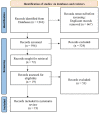Implemented indoor airborne transmission mitigation strategies during COVID-19: a systematic review
- PMID: 37152068
- PMCID: PMC9968468
- DOI: 10.1007/s40201-023-00847-0
Implemented indoor airborne transmission mitigation strategies during COVID-19: a systematic review
Abstract
The COVID-19 pandemic has inflicted major economic and health burdens across the world. On the other hand, the potential airborne transmission of SARS-COV-2 via air can deeply undermine the effectiveness of countermeasures against spreading the disease. Therefore, there is an intense focus to look for ways to mitigate the COVID-19 spread within various indoor settings. This work systematically reviewed articles regarding airborne transmission of SARS-COV2 in various indoor settings since the onset of the pandemic. The systematic search was performed in Scopus, Web of Science, and PubMed databases and has returned 19 original articles carefully screened with regard to inclusion and exclusion criteria. The results showed that the facilities, such as dormitories and classrooms, received the most attention followed by office buildings, healthcare facilities, residential buildings, and other potential enclosed spaces such as a metro wagon. Besides, the majority of the studies were conducted experimentally while other studies were done using computer simulations. United States (n = 5), Spain (n = 4) and China (n = 3) were the top three countries based on the number of performed research. Ventilation rate was the most influential parameter in controlling the infection spread. CO2 was the primary reference for viral spread in the buildings. The use of natural ventilation or a combination of mechanical and natural ventilations was found to be highly effective in the studies. The current work helps in furthering research on effective interventions to improve indoor air quality and control the spread of COVID-19 and other respiratory diseases.
Supplementary information: The online version contains supplementary material available at 10.1007/s40201-023-00847-0.
Keywords: Airborne transmission; COVID-19; Indoor air quality; SARS-COV-2; Systematic review; Ventilation strategies.
© The Author(s), under exclusive licence to Tehran University of Medical Sciences 2023, Springer Nature or its licensor (e.g. a society or other partner) holds exclusive rights to this article under a publishing agreement with the author(s) or other rightsholder(s); author self-archiving of the accepted manuscript version of this article is solely governed by the terms of such publishing agreement and applicable law.
Conflict of interest statement
Competing interestsThe authors declare that there are no conflicts of interest.
Figures
References
-
- Yazdani Mohsen, Baboli Zeynab, Maleki Heidar, Birgani Yaser Tahmasebi, Zahiri Maryam, Chaharmahal Seyede Saba Heydari, Goudarzi Mahdis, Mohammadi Mohammad Javad, Alam Khan, Sorooshian Armin, Goudarzi Gholamreza. Contrasting Iran’s air quality improvement during COVID-19 with other global cities. Journal of Environmental Health Science and Engineering. 2021;19(2):1801–1806. doi: 10.1007/s40201-021-00735-5. - DOI - PMC - PubMed
-
- Sodiq A, Khan MA, Naas M, Amhamed A, Addressing COVID-19 contagion through the HVAC systems by reviewing indoor airborne nature of infectious microbes: will an innovative air recirculation concept provide a practical solution? Environ Res. 2021;199:111329. doi: 10.1016/j.envres.2021.111329. - DOI - PMC - PubMed
Publication types
LinkOut - more resources
Full Text Sources
Miscellaneous




